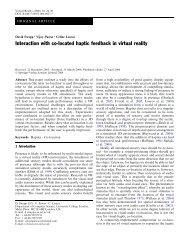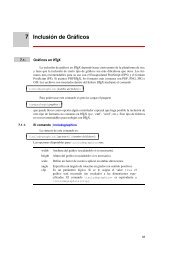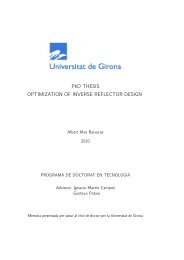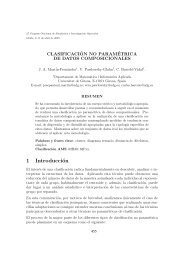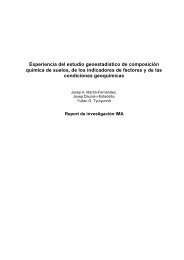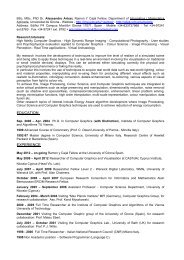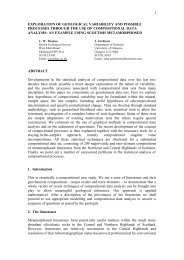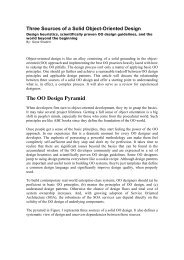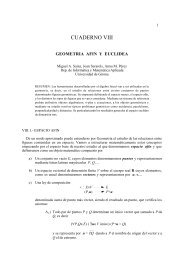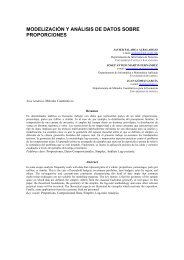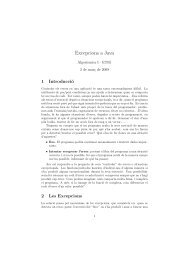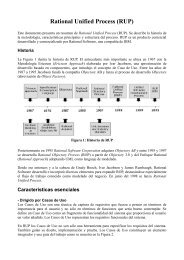This results in<strong>to</strong> <strong>the</strong> replication of <strong>the</strong> constraint m[i]m[i-1] with <strong>the</strong> localvariable i being replaced by <strong>the</strong> appropriate values (<strong>the</strong> compilation techniquesused for <strong>the</strong> expansion are quite similar <strong>to</strong> <strong>the</strong> ones used for comprehension lists):m[2]m[1]; m[3]m[2]; m[4]m[3];Lists can be extensional, by directly enumerating elements and ranges e.g.,[1, x, 3..5, m[a]+3], or intensional via comprehension lists à la Haskell. Thispowerful and expressive feature allows us <strong>to</strong> generate complicated lists easily. Weillustrate its usage with <strong>the</strong> following example:[ m[i,j] | i in [1..3], j in [1..3], ij ]results in<strong>to</strong>[ m[1,2], m[1,3], m[2,1], m[2,3], m[3,1], m[3,2] ]The first part of a comprehension list is <strong>the</strong> pattern, i.e., <strong>the</strong> expressionthat we want <strong>to</strong> generate. Currently, patterns must be arithmetic expressions(in this example, <strong>the</strong> elements of <strong>the</strong> bidimensional array m). The rest of <strong>the</strong>comprehension list is formed by two distinct kinds of expressions, namely, <strong>the</strong>genera<strong>to</strong>rs (in <strong>the</strong> example, i in [1..3] and j in [1..3], that expand <strong>the</strong>pattern) followed by <strong>the</strong> filters, that restrict <strong>the</strong>se expansions (e.g., ij).3.3 CompilationThe compiler has been implemented in Haskell. The compilation process hastwo steps: <strong>the</strong> first step only checks for syntactic compliance and some minorsemantic details, and generates an intermediate code. The second step is <strong>the</strong>one in charge of semantic analysis and <strong>the</strong> final <strong>SMT</strong>-<strong>LIB</strong> code generation. Thiscode generation step distinguishes between expressions that must be evaluatedat compilation time (such as, for instance, <strong>the</strong> expressions in <strong>the</strong> condition of <strong>the</strong>If-Then-Else statement), or translated in<strong>to</strong> <strong>SMT</strong>-<strong>LIB</strong> expressions (for instancea basic constraint).The names of <strong>the</strong> variables are preserved <strong>from</strong> <strong>the</strong> input file <strong>to</strong> <strong>the</strong> resulting<strong>SMT</strong>-<strong>LIB</strong> formula. The only exceptions are arrays: for instance, m[10] istranslated in<strong>to</strong> ten <strong>SMT</strong> variables m 1,m 2,...,m 10.The function in charge of <strong>the</strong> final code generation is codeGeneration, whichreceives an IntermediateCode and returns a String with <strong>the</strong> generated code. Toillustrate <strong>the</strong> simplicity and convenience of using Haskell for <strong>the</strong> code generationstep, in Fig. 5 we show <strong>the</strong> codeGeneration function for <strong>the</strong> intermediate codeof <strong>the</strong> global constraint Count. First of all, <strong>the</strong> function unfolds list and obtains<strong>the</strong> value of value. Then, it generates <strong>the</strong> list of <strong>the</strong> comparisons between <strong>the</strong>elements of <strong>the</strong> unfolded list and <strong>the</strong> value that we are looking for. Next, itapplies <strong>the</strong> ite opera<strong>to</strong>r <strong>to</strong> each element reifying <strong>the</strong>se comparisons 1 . In <strong>the</strong>end, it returns <strong>the</strong> string that enforces <strong>the</strong> value of times <strong>to</strong> be equal <strong>to</strong> <strong>the</strong> sumof <strong>the</strong> reifications.1 Notice that <strong>the</strong> <strong>SMT</strong>-<strong>LIB</strong> ite opera<strong>to</strong>r will return 1 when <strong>the</strong> comparison is satisfiedand 0 o<strong>the</strong>rwise.
codeGeneration :: IntermediateCode -> StringcodeGeneration (COUNT list value times)= codewherel = (unfoldList list)v = (expValue value)comps = map (\x -> "(= "++ x ++" "++ v ++")") lreifi = map (\x -> "(ite "++ x ++" 1 0 )") compssum = "(+ "++ (concat reifi) ++")"code = "(= "++(expValue times)++" "++sum++")"Fig. 5. Haskell code for compiling <strong>the</strong> Count global constraint.4 Examples and BenchmarksIn <strong>the</strong> following we describe <strong>the</strong> decisional <strong>CSP</strong>s used in our benchmarks andillustrate <strong>the</strong> use of Simply for one of <strong>the</strong>m. The problems are <strong>the</strong> following:– <strong>CSP</strong>Lib [6] problem 015, Schur’s Lemma. The problem is <strong>to</strong> put n ballslabelled {1, . . . , n} in<strong>to</strong> 3 boxes so that, for any triple of balls (x, y, z) withx + y = z, not all are in <strong>the</strong> same box. This problem has a solution iffn < 14. In <strong>the</strong> table of Fig. 7, <strong>the</strong> entry Schurl i j denotes <strong>the</strong> instance of<strong>the</strong> problem with i balls and j boxes.– <strong>CSP</strong>Lib problem 030, Balanced Academic Curriculum Problem (BACP). TheBACP objective is <strong>to</strong> design a balanced academic curriculum by assigningperiods <strong>to</strong> courses in a way such that <strong>the</strong> academic load of each period isbalanced, i.e., as similar as possible. The curriculum must obey <strong>the</strong> followingadministrative and academic regulations:1. Courses must be assigned within a maximum number of academic periods(n periods).2. Each course has a number of credits or units that represent <strong>the</strong> academiceffort required <strong>to</strong> successfully follow it (course load[n courses]).3. Some courses can have o<strong>the</strong>r courses as prerequisites.4. A minimum amount of academic credits per period is required <strong>to</strong> considera student as full time, and a maximum amount of academic creditsper period is allowed in order <strong>to</strong> avoid overload (load per period lb,load per period ub).5. A minimum number of courses per period is required <strong>to</strong> consider a studentas full time, and a maximum number of courses per period is allowedin order <strong>to</strong> avoid overload (courses per period lb, courses per periodub).The goal is <strong>to</strong> assign a period <strong>to</strong> every course in a way such that <strong>the</strong>minimum and maximum academic load for each period, <strong>the</strong> minimum andmaximum number of courses for each period, and <strong>the</strong> prerequisite relationshipsare satisfied. In Fig. 6 we can find <strong>the</strong> modeling used in <strong>the</strong>



